|
Genus: Ixia
Life
> eukaryotes >
Archaeoplastida >
Chloroplastida
>
Charophyta > Streptophytina > Plantae (land plants)
> Tracheophyta (vascular plants) > Euphyllophyta > Lignophyta (woody plants)
> Spermatophyta (seed plants) > Angiospermae (flowering
plants) > Monocotyledons > Order: Asparagales
> Family: Iridaceae
Endemic to Western Cape, Northern Cape and Eastern
Cape, with 69 species present.
Some species are pollinated by bees others by monkey
beetles. The long-tongued flies Moegistorhynchus longirostris (Nemestrinidae)
and Philoliche rostrata (Tabanidae) pollinate Ixia paniculata.
Philoliche rostrata also pollinates other long-tubed species such as Ixia
longituba and Ixia pauciflora (Goldblatt & Manning 2000).
Species native to southern Africa
List from
Plants
of Southern Africa - an Online Checklist (SANBI) and
Red List of South African Plants: Ixia.
|
Ixia abbreviata
Var. abbreviata, considered Near
Threatened, occurs from Piketberg to Paarl on clay and
gravel slopes and flats in renosterbos whereas Var.
ovata, considered, Endangered, occurs from Piketberg to
Porterville on sandy, usually damp, flats.
|
 |
|
Ixia acaulis
Distribution is limited to the farm
Rooiberg on the Knersvlakte, near Vanrhynsdorp, Western
Cape, South Africa, where it occurs in rock cracks on
limestone ridges. Unusual for Ixia in having a
short, subterranean stem with single, terminal flowers
and a subterranean ovary.
|
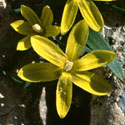 |
|
Ixia
alata
Roggeveld Escarpment south of
Calvinia, Northern Cape, South Africa, in deep clay and
sandy soils among rocky outcrops on gentle slopes
|
|
|
Ixia amethystina
Occurs near Middelpos on the Roggeveld
Escarpment, Northern Cape, South Africa.
|
|
|
Ixia atrandra
Occurs from Villiersdorp to Worcester,
Western Cape, South Africa,
in renosterveld on clay soils.
|
 |
|
Ixia aurea
Occurs in a few isolated populations
from Piketberg to Citrusdal and Darling, Western Cape,
South Africa. Known from Granite Fynbos above the
Darling to Yzerfontein road.
|
|
|
Ixia
bellendenii
Known only from Jonaskop in the
Riviersonderend Mountains, Western Cape, South Africa,
where it is found in fynbos on lower and middle slopes
facing north, among rocks in loamy sand.
|
|
|
Ixia brevituba
Distribution is limited to near the
escarpment on the Roggeveld plateau, south and southwest
of Sutherland, Northern Cape, South Africa. Occurs on
wet clay flats along water courses.
|
|
|
Ixia brunneobractea
Occurs near Nieuwoudtville in the
Northern Cape, South Africa, in marshy places close to
the edge of the escarpment (600-900 m elevation).
Prefers deep sandy soils.
|
|
|
Ixia calendulacea
Broadly distributed on the West Coast
coastal plain, from the Groenrivier Mouth in the
Northern Cape to Langebaan in the Western Cape, South
Africa, and occurring inland to Porterville and the
Olifants River Valley. Also recorded from a small
population on the Cape Flats, near Cape Town.
|
|
|
Ixia campanulata
Occurs on sandy flats and at the foot
of mountains in the Tulbagh, Paarl and Worcester
districts of the Western Cape, South Africa.
|
|
|
Ixia capillaris
Widespread in the southwestern region
of the Western Cape, South Africa: from Clanwilliam to
Cape Town, Ceres, Worcester, Ladismith, Laingsburg and
Riversdale. Has a broad habitat range that includes
flats, hills and mountain slopes, in sandy or clay
soils.
|
|
|
Ixia cedarmontana
Distribution includes the Cederberg,
Koue Bokkeveld and Groot Winterhoek mountains, Western
Cape, South Africa, where it occurs on moist sandstone
flats, and in seeps and seasonal marshes.
|
|
|
Ixia cochlearis
Occurs or occurred on the slopes of
the Jonkershoek and Banhoek Mountains near Stellenbosch,
Western Cape, South Africa, but has not been recorded
since 1946.
|
|
|
Ixia collina
Distribution is limited to the Breede
River valley south of Worcester, where it occurs on
moist, south-facing clay slopes of hills with karoo
vegetation.
|
|
|
Ixia contorta
|
|
|
Ixia curta
Occurs on sandy flats and hill slopes
in the Darling, Malmesbury, Hopefield and Saldanha
districts, Western Cape, South Africa.
|
|
|
Ixia curvata
Occurs on the Calvinia and Great
Roggeveld plateau.
|
|
|
Ixia dieramoides
|
|
|
Ixia divaricata
Ranges from the south-western
Cederberg east of Citrusdal, through the Koue Bokkeveld
to the Hex River Mountains. Occurs on seasonally wet,
stony sandstone flats.
|
|
|
Ixia dolichosiphon
Known only from fynbos on the lower
stony southern slopes of the Keeromsberg in the Hex
River Valley, Western Cape, South Africa.
|
|
|
Ixia dubia
Distributed from Piketberg to the Cape
Peninsula, to Caledon, Western Cape, South Africa.
Occurs in fynbos on sandy flats and mountain slopes.
|
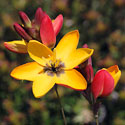 |
|
Ixia ecklonii
Only recorded once, in the early 19th
Century. No locality was given but it is considered to
have been collected from the Olifants River Valley, near
Citrusdal, Western Cape, South Africa. Possibly extinct.
|
|
|
Ixia erubescens
Distribution extends from Piketberg
and Tulbagh to Worcester, Paarl, Stellenbosch, and to
Caledon, Western Cape, South Africa (de Vos, 1999a).
Occurs on stony or clay flats and hill slopes.
|
|
|
Ixia esterhuyseniae
Occurs in a small area of fynbos on
the Jonkershoek and Hottentot Holland Mountains, Western
Cape, South Africa, at an elevation of 900-1200 m (de
Vos, 1999a). Grows in seeps and along drainage lines
|
|
|
Ixia exiliflora
|
|
|
Ixia flexuosa
Distribution extends from the Cape
Peninsula to Riversdale in the Western Cape, South
Africa. It has a broad habitat tollerance, being found
on flats, hills and mountain slopes, in clay or sandy
soils
|
|
|
Ixia fucata
|
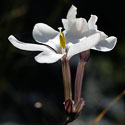 |
|
Ixia gloriosa
|
|
|
Ixia lacerata
|
|
|
Ixia latifolia
|
 |
|
Ixia leipoldtii
|
|
|
Ixia longituba
|
|
|
Ixia maculata
|
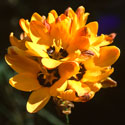 |
|
Ixia marginifolia
|
|
|
Ixia metelerkampiae
|
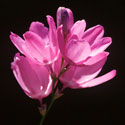 |
|
Ixia micrandra
|
 |
|
Ixia monadelpha
|
|
|
Ixia mostertii
|
|
|
Ixia namaquana
|
|
|
Ixia odorata
|
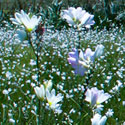 |
|
Ixia orientalis
|
|
|
Ixia oxalidiflora
|
|
|
Ixia paniculata
|
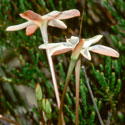 |
|
Ixia patens
|
|
|
Ixia pauciflora
|
|
|
Ixia paucifolia
|
|
|
Ixia polystachya
|
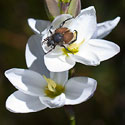 |
|
Ixia pumilio
|
|
|
Ixia purpureorosea
|
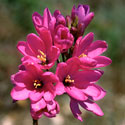 |
|
Ixia rapunculoides
|
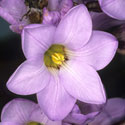 |
|
Ixia reclinata
|
|
|
Ixia rivulicola
|
|
|
Ixia robusta
|
|
|
Ixia rouxii
|
|
|
Ixia scillaris
|
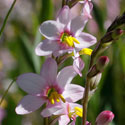 |
|
Ixia sobolifera
|
|
|
Ixia splendida
|
|
|
Ixia stohriae
|
|
|
Ixia stolonifera
|
|
|
Ixia stricta
|
|
|
Ixia superba
Recorded from a small area at the foot
of the Langeberg in the Little Karoo, east of Montagu,
Western Cape, South Africa; growing in loamy, sandstone
to light clay soils at the interface between Table
Mountain Sandstone and Bokkeveld shales.
|
|
|
Ixia tenuifolia
|
 |
|
Ixia thomasiae
|
|
|
Ixia trifolia
|
|
|
Ixia trinervata
|
|
|
Ixia vanzijliae
|
|
|
Ixia versicolor
|
|
|
Ixia vinacea
|
|
|
Ixia viridiflora
|
|
Publications (by date)
-
Lewis GJ. 1962. South African Iridaceae. The
genus Ixia. Journal of South African Botany 28: 45-195.
-
de Vos MP. 1999. Ixia. In: Flora of southern Africa
7(2),
fascicle 1: 3-87.
-
Goldblatt P, Bernhardt P, Manning JC. 2000. Adaptive
radiation of pollination mechanisms in Ixia (Iridaceae: Crocoideae).
Annals of the Missouri Botanical Garden 87(4): 564-577.
jstor
-
Goldblatt P, Manning JC. 2000. Iridaceae. In: In: Seed Plants of
Southern Africa (ed. O.A. Leistner). Strelitzia 10: 623-638.
National Botanical Institute, Pretoria.
-
Goldblatt P, Manning JC. 2001. Two new renosterveld species
of Crocoideae from South Africa. Bothalia 31(2):189-212.
-
Manning JC, Goldblatt P. 2006. New species of
Iridaceae from the Hantam-Roggeveld Centre of Endemism, and the Bokkeveld,
Northern Cape, South Africa. Bothalia 36(2):139-145.
-
Goldblatt P, Manning JC. 2008. Systematics of the southern
African genus Ixia (Iridaceae). 1. The I. rapunculoides
complex. Bothalia 38(1): 1-22.
-
Goldblatt P, Manning JC. 2010. Iridaceae: Reappraisal
of Ixia maculata with I. calendulacea sp. nov., and an earlier
name for I. lutea. Bothalia 40(1): 59-64.
-
Goldblatt P, Manning JC. 2011. Systematics of the
southern African genus Ixia (Iridaceae). 3. Sections Hyalis and
Morphixia. Bothalia 41(1):83-134.
|
